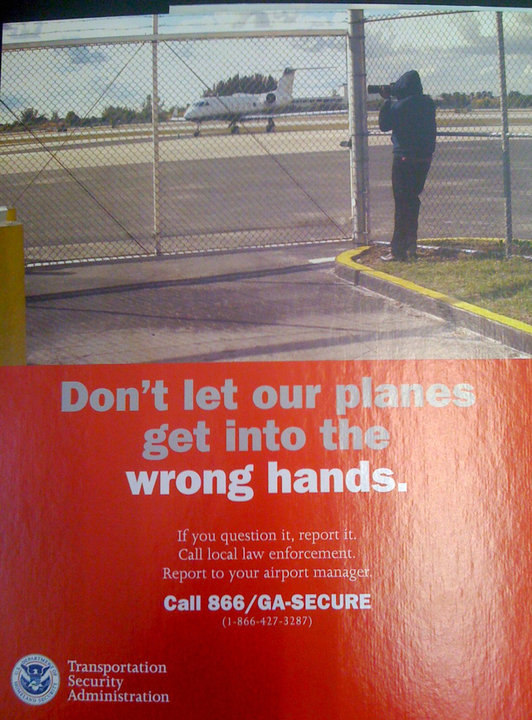
Are you a photographer? Do you like to take photos when you travel, maybe at airports? How about airplanes? Marvels of technical achievement, they inspire awe, and some photographers like to take their pictures. The new Boeing 787 Dreamliner is a beautiful machine, amazingly graceful despite its size. It looks good in a picture.
But, if you’re a photographer, you’re probably also a terrorist — at least that is what the Transportation Security Agency seems to be saying in its newest advertisement purporting to educate us about threats to security.
The advertisement in question shows a photographer aiming his lens through a chain link fence at an airfield. Sitting on the tarmac is what the TSA calls “a GA aircraft” — GA standing for “General Aviation” and the aircraft in question being a two-engine executive jet.

The ad goes on to implore citizens who are not photographers not to “let our planes get into the wrong hands,” and to “question” suspicious activity and to “call local law enforcement” and “report to your airport manager.”
All this, apparently, to rat out dangerous photographers, despite the fact that there is not a single example of terrorists using photography to plan a terrorist attack. That’s a crucial point made by Erin McCann writing for the WeLoveDC blog.
“I cannot believe that we have to continually point this out to the people who are in charge of our national security,” Erin writes,” but here it goes again: there has not been a single documented instance in which a terrorist or someone accused of involvement in a terrorist plot surveilled a location with a camera before carrying out that plot. NONE.”
McCann also cites security expert Bruce Schneier who wrote on that subject in 2008:
The 9/11 terrorists didn’t photograph anything. Nor did the London transport bombers, the Madrid subway bombers, or the liquid bombers arrested in 2006. Timothy McVeigh didn’t photograph the Oklahoma City Federal Building. The Unabomber didn’t photograph anything; neither did shoe-bomber Richard Reid. Photographs aren’t being found amongst the papers of Palestinian suicide bombers. The IRA wasn’t known for its photography. Even those manufactured terrorist plots that the US government likes to talk about — the Ft. Dix terrorists, the JFK airport bombers, the Miami 7, the Lackawanna 6 — no photography.
Sadly, it should come as no surprise that TSA would callously and inaccurately smear photographers as terrorists when average citizens on innocuous business trips find themselves caught up in the TSA’s anti-terror dragnet.
Consider what happened to the ever so suspicious looking Kathy Parker. The blonde 43-year-old business woman with a perky smile, described by Philadelphia Inquirer columnist Daniel Rubin as “a business support manager for a large bank,” was selected by a TSA “behavior detection officer” for advanced invasive “screening” while on her way to Charlotte, North Carolina, for a business trip.
Her purse was taken and the contents rifled. When the TSA officer violating Mrs. Parker’s Fourth Amendment rights found her diet pills, the officer asked her: “Hey, I’ve always been curious about these. Do they work?”
“This was embarrassing,” Parker recounted, but it was only a prelude. What came next was startlingly inappropriate. In a pocket, apparently on her purse, she had a bank deposit slip and seven checks made out to her husband, totaling about $8,000. They were numbered in sequence. This, to the TSA, was evidence of a great crime and they called over two Philadelphia police officers.
This is “an indication you’ve embezzled these checks,” the police officers told her.
“That’s my money,” she protested.
“It’s not your money,” the apparently omniscient officer replied.
After getting the telephone number of Parker’s husband, the intrepid crime fighters called him to alert him to his wife’s criminal and terrorist ties. They told him, he recounted, that they suspected “a divorce situation.”
“I was so humiliated,” Mrs. Parker recalled.
The TSA’s response to all this was to place the blame for the situation on Mrs. Parker. She aroused suspicion, a TSA spokesman said, because she acted “as if she feared discovery.”
As well she might have. And so should every traveller cursed with having to pass through an airport these days, running a gauntlet of government sponsored thugs who have been given a special dispensation allowing them to violate the constitutional rights of citizens whenever they wish. Abuse people with unconstitutional, random, disruptive, embarrassing, and unnecessary searches on a regular basis and you can reliably expect that the victims of that abuse will become increasingly circumspect and nervous as they try hard to avoid attracting the attention of government agents.
The growing ranks of nervous air travellers, of course, will give government operatives even more of a reason to conduct their oppressive searches. Ultimately, this amounts to a vicious circle leading inexorably to a thoroughly dehumanizing surveillance and police state.
And that means tyranny for everyone, including bankers and photographers.
Dennis Behreandt is a Senior Editor for The New American magazine. Visit his blog and archives here.


